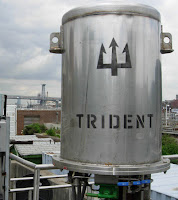Catalyst ‘presulfiding’ is a practice which reduces the extent of early catalyst deactivation on by preventing coking (carbon deposits). The procedure involves passing a gas stream containing H2S over the catalyst or into the reaction feedstock.
In order to generate the H2S which will interact with the catalyst, a sulfur carrying agent (e.g. dimethyl sulfide) is injected into the stream. Under high temperature and catalytic reaction, the agent decomposes and releases its sulfur component, forming H2S. The H2S reacts with the catalyst’s metallic surface to substitute sulfur atoms for oxygen atoms.
Read the document below to learn more about monitoring this process with the Applied Analytics OMA-300 H2S Analyzer
Educational information on process control, industrial instrumentation, valves, valve automation and control valves. For additional information visit IvesEquipment.com or call 877-768-1600
Ives Equipment Business Groups
Ives Equipment organizes its extensive product line into four distinct groups:
Ives Equipment and Controls, providing instrumentation and control products to the chemical, petro-chemical, refining, bulk storage, primary metals, pulp & paper, powergen, gas & oil distribution and OEM markets.
Pharmaceutical, Bio-pharm, and Sanitary, providing hygienic, ultra-pure and sanitary instruments, connectors, fittings, tubing and gaskets to the pharma, bio-pharm, food and beverage, life-science and labortory industries.
Analytical Instruments, used to analyze process material samples and record the data for quality, conformance and compliance.
Water and Wastewater Treatment, providing instruments, analyzers, valves and controls for the transfer, storage, analysis, treatment, and logging of municipal and industrial water treatment systems.
Ives Equipment and Controls, providing instrumentation and control products to the chemical, petro-chemical, refining, bulk storage, primary metals, pulp & paper, powergen, gas & oil distribution and OEM markets.
Pharmaceutical, Bio-pharm, and Sanitary, providing hygienic, ultra-pure and sanitary instruments, connectors, fittings, tubing and gaskets to the pharma, bio-pharm, food and beverage, life-science and labortory industries.
Analytical Instruments, used to analyze process material samples and record the data for quality, conformance and compliance.
Water and Wastewater Treatment, providing instruments, analyzers, valves and controls for the transfer, storage, analysis, treatment, and logging of municipal and industrial water treatment systems.
Definition: Industrial Valve Actuator
 |
| Pneumatic actuator on ball valve. (Worcester) |
 |
| Electric actuator (Worcester) |
In a control loop, the controller has an input signal parameter, registered from the process, and compares it to a desired setpoint parameter. The controller adjusts its output to eliminate the difference between the process setpoint and process measured condition. The output signal then drives some control element, in this case the actuator, so that the error between setpoint and actual conditions is reduced. The output signal from the controller serves as the input signal to the actuator, resulting in a repositioning of the valve trim to increase or decrease the fluid flow through the valve.
 |
| Electro-hydraulic actuator (MIH Trident) |
Hydraulic and electric actuators are readily available in multi-turn and quarter-turn configurations. Pneumatic actuators are generally one of two types applied to quarter-turn valves: scotch-yoke and rack and pinion. A third type of pneumatic actuator, the vane actuator, is also available.
For converting input power into torque, electric actuators use motors and gear boxes while pneumatic actuators use air cylinders. Depending on torque and force required by the valve, the motor horsepower, gearing, and size of pneumatic cylinder may change.
There are almost countless valve actuator variants available in the industrial marketplace. Many are tailored for very narrow application ranges, while others are more generally applied. Special designs can offer more complex operating characteristics. Ultimately, when applying actuators to any type of device, consultation with an application specialist is recommended to help establish and attain proper performance, safety and cost goals, as well as evaluation and matching of the proper actuator to the valve operation requirements. Share your fluid process control requirements with a specialist in valve automation, combining your own process knowledge and experience with their product application expertise to develop effective solutions.
Contact Ives Equipment for any valve actuator application. Visit http://www.ivesequipment.com or call (877) 768-1600.
Labels:
actuator,
Delaware,
industrial valve,
Maryland,
New Jersey,
New York,
Pennsylvania,
valve actuation,
Virginia
Principles of Ultrasonic Flow in Industrial Clamp On Flow Meters
The video below demonstrate the principles applied to industrial clamp on flow meters using the SITRANS FS as an example.
The ultrasonic technology of the SITRANS clamp on flow meter provides highly accurate measurement of liquids and gases. With no pressure drop or energy loss, a wide turn-down ratio and no need to cut the pipe or stop the flow, installation is easy and maintenance is minimal.
For more information about ultrasonic flow meters, contact Ives Equipment at 877-768-1600 or visit http://www.ivesequipment.com.
The ultrasonic technology of the SITRANS clamp on flow meter provides highly accurate measurement of liquids and gases. With no pressure drop or energy loss, a wide turn-down ratio and no need to cut the pipe or stop the flow, installation is easy and maintenance is minimal.
For more information about ultrasonic flow meters, contact Ives Equipment at 877-768-1600 or visit http://www.ivesequipment.com.
Labels:
Clamp On,
Delaware,
Flow,
Flow Meters,
Industrial,
Maryland,
New Jersey,
New York,
Pennsylvania,
Siemens,
SITRANS,
Ultrasonic,
Virginia
Subscribe to:
Posts (Atom)

